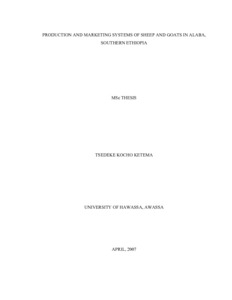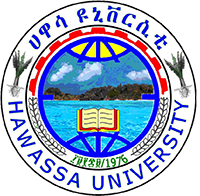Resource information
This study has undertaken to describe the sheep and goat production and marketing systems and identify constraints to and improvement options for smallholder farms of Alaba, southern Ethiopia. Results are based on survey of 150 sample households and rapid appraisal of major sheep and goat markets. Flock distribution and holdings in different parts of the woreda vary and thus the study sites were stratified into mixed sheep-goat flock, goat dominating and sheep dominating sites. Average family size of the study area was 6.7. Literacy of household heads accounts 30%. Across the sites, mean holdings of total land, grazing land, cattle, sheep, goat and equine numbers varied significantly (P<0.05) with the goat dominating site having higher values) than the others. With respect to livestock holdings above half of the total TLU was recorded in goat dominant site. The mean holding of 7.4 sheep (P<0.05) and 11.5 goats (P<0.05), respectively are higher in sheep and goat dominating sites. Sheep and goats are primarily kept for sale to generate cash and majorities (98.9%) of goat owners extensively milk their flock for household consumption. Sucking young (22.8% lambs; 26.7% kids) and breeding female (39.3% ewes; 39.4% does) dominate the flock. Respondents reported that grazing on crop stubble (13.4%), private pastures (13.3%) and road sides (13.2%), weeds (11.6%), tillers and fillers (8.9%) from crop fields, cut-and-carry of browse species and grasses (9.1%) and communal pastures (9.4%) are major feedstuffs of sheep and goats. Flock water are largely comes from rivers (Bilate and Dijo) (55.2%), artificial ponds (21.9%), trough and harvested water. Diseases and parasites cause significant (P<0.05) losses of flocks (34.6%). Rate of loss is higher in young (35.0% lambs; 35.5% in kids) and mothers (42.9% in ewes; 30.6% in does). Losses by predators is noticeably higher (P<0.05) in goat dominating site. Body conformation, physical characteristics (coat color, horn and tail), known local ecotypes and age are the major criteria household considers in selecting sheep and goats for castration and fattening. Smallholder farmers make fattening management targeting the seasonal holiday markets. Major destination of fattened flocks is the Addis Ababa market while young flocks to the export abattoirs. Addis Ababa consumers demonstrated high preferences to animals from study areas and evidently pay higher prices. This is largely exploitable opportunity for development of smallholder sheep and goat production. Flock production is constrained by outbreaks of disease and parasite, predators, feed and water shortage, lack of production technology and seasonality of markets. Interventions covering flock health, feed production and managements, water development, marketing, credits to build flock holdings, and extension supports delivering the necessary training and production technologies/inputs could help farmers to built their flock and improve productivity. KEY WORDS: Sheep, Goats, Smallholder farmers, Production systems, Marketing systems, Constraints, Improvement options, Alaba, Southern Ethiopia.



